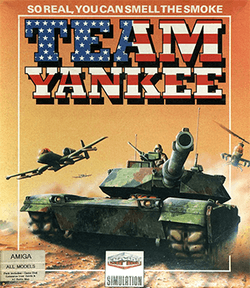Team Yankee (video game)
Team Yankee is a video game adaptation of the 1987 Harold Coyle's World War III novel Team Yankee that was developed by British studio Oxford Digital Enterprises for the Amiga, Atari ST, MS-DOS and Commodore CDTV systems.
| Team Yankee | |
|---|---|
 | |
| Developer(s) | Oxford Digital Enterprises |
| Publisher(s) | Empire Software |
| Artist(s) | Kevin R. Ayre Gareth B. Williams |
| Platform(s) | Amiga, Atari ST, MS-DOS, CDTV |
| Release | 1987 |
| Genre(s) | Strategy Simulation |
| Mode(s) | Single player |
It was released in 1990 by publisher Empire Software, and was followed by two sequels that used the same game engine (titled Pacific Islands and War in the Gulf). Team Yankee is a mixture of real-time strategy and simulation game and uses a 3D environment and 2D sprites. The player is able to use several well-known late Cold War-era tanks and other armoured vehicles (M1 Abrams, M2 Bradley IFV, M113, T-72, T-62 and BMP-2).
Reception
1992 and 1994 Computer Gaming World surveys of wargames with modern settings gave the game two stars out of five, describing it as "an arcade-like product trying to pass as a simulation of modern tactical armored warfare".[1][2] A full review by the magazine in 1992 criticized Team Yankee's lack of infantry (making the machines guns useless) or air power (despite the aircraft on the box art). The magazine concluded that it, while more realistic than Pacific Islands, was not for "the hard-core wargamer, but are for people who enjoy a quick and relatively easy run-through of a tank game".[3]
References
- Brooks, M. Evan (June 1992). "The Modern Games: 1950 - 2000". Computer Gaming World. p. 120. Retrieved 24 November 2013.
- Brooks, M. Evan (January 1994). "War In Our Time / A Survey Of Wargames From 1950-2000". Computer Gaming World. pp. 194–212.
- Savage, Richard (December 1992). "Empire's Team Yankee & Pacific Islands". Computer Gaming World. p. 172. Retrieved 5 July 2014.